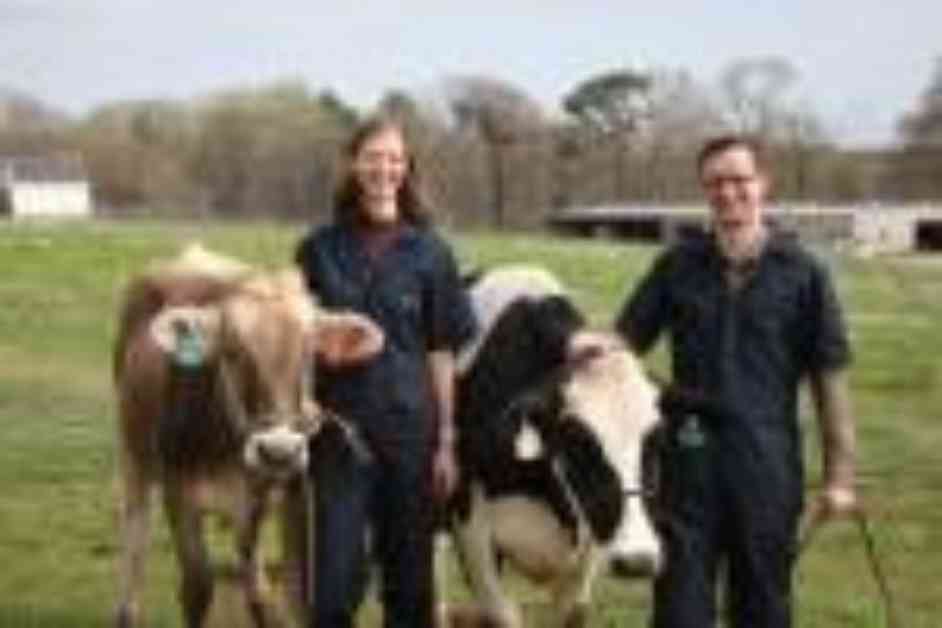Sometimes, answering a long-standing problem is a matter of finding a new perspective. Take methane from cows, for example. People have been trying to eliminate the gas from cow burps for years to limit the livestock’s impact on the climate. But they haven’t made a dent. Why, you ask? Well, they were looking at the issue from the perspective of a climate scientist, not a farmer.
But fear not, Kathryn Polkoff, co-founder and CEO of Hoofprint Biome, has a different approach. She’s been thinking about the problem more like a farmer. “The first time I heard about this methane problem was animal science 101,” Polkoff, who holds a PhD in animal science, told TechCrunch. It wasn’t in the context of climate change, but of animal health and productivity.
Polkoff, along with her co-founder Scott Collins, have come up with a unique way to modify a cow’s microbiome using enzymes. This genius idea not only slashes methane but also boosts the nutrients available to the cow. And guess what? Their discovery has led Hoofprint to secure a $15 million Series A round led by SOSV. Other participating investors include AgriZeroNZ, Alexandria Venture Investments, Amazon’s Climate Pledge Fund, Breakthrough Energy Fellows, Good Growth Capital, Ponderosa Ventures, and Twynam. This new round will help the company trial its enzymes on farms.
“We’ve spent thousands of years breeding the animals to make them as efficient as possible and to increase the yield, but there have not really been that many attempts to change a microbiome,” she said. “That’d be like if you were engineering a car but had never changed the engine – that’s where all the energy comes from.”
Hoofprint’s feed additive works by tweaking the microbiome in a cow’s rumen and suppressing the growth of microbes that generate methane, a potent greenhouse gas that warms the planet 84 times more than the same amount of carbon dioxide.
Rumen is like a “hodgepodge assembly line,” said Po Bronson, the SOSV general partner who led the firm’s investment in Hoofprint. The stuff cows eat tends to be very hard to digest and extract nutrients from. Over the millennia, cows have evolved alongside a complex microbiome in the rumen that helps break down the forage, releasing nutrients in the process.
The cow absorbs some of those nutrients, but not all. Another group of microbes steals some of those nutrients to drive their growth at the expense of the cow’s, generating methane as a byproduct. “It’s a very specific subset of microbes that are making the methane,” Polkoff said.
Hoofprint’s enzyme suppresses those microbes. The startup will use yeast to make the enzymes, similar to how other industrial enzymes are made, including those used in cheese, detergent, and other products.
For Bronson at SOSV, the fact that Hoofprint’s enzymes are derived from the rumen itself was key. One previous methane-reducing product, Bovaer, faced a wave of disinformation when a large food company announced trials in the UK in December.
He doesn’t think that Hoofprint will face the same backlash. “The core concept is that their product is a natural protein. They degrade just like any other protein an animal would eat. They’re sort of natural to the rumen.”
Hoofprint is targeting a 5% improvement in “feed efficiency,” Polkoff said, or how many more pounds a cow can put on for a given amount of feed.
By improving the efficiency of a cow’s rumen, Bronson is confident Hoofprint will be able to succeed with farmers where other startups have failed. “Knocking down methane is table stakes,” he said. “To make it a more productive thing is what they will pay for.”
Tim De Chant is a senior climate reporter at TechCrunch. He has written for a wide range of publications, including Wired magazine, the Chicago Tribune, Ars Technica, The Wire China, and NOVA Next, where he was founding editor. De Chant is also a lecturer in MIT’s Graduate Program in Science Writing, and he was awarded a Knight Science Journalism Fellowship at MIT in 2018, during which time he studied climate technologies and explored new business models for journalism. He received his PhD in environmental science, policy, and management from the University of California, Berkeley, and his BA degree in environmental studies, English, and biology from St. Olaf College.













